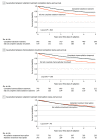Factors Associated With Chemoradiation Therapy Interruption and Noncompletion Among Patients With Squamous Cell Anal Carcinoma
- PMID: 32324199
- PMCID: PMC7180731
- DOI: 10.1001/jamaoncol.2020.0809
Factors Associated With Chemoradiation Therapy Interruption and Noncompletion Among Patients With Squamous Cell Anal Carcinoma
Abstract
Importance: Definitive chemoradiation for anal cancer is effective but may be associated with toxic effects, and some patients may not be able to complete the planned treatment. Identifying factors associated with treatment interruption and noncompletion is important to target quality improvement efforts.
Objective: To identify rates of chemoradiation treatment interruption or noncompletion and factors associated with this among patients with anal cancer treated in routine clinical practice.
Design, setting, and participants: In this population-based, retrospective cohort study, the Ontario Cancer Registry was used to identify all incident cases of squamous cell anal cancer treated with curative-intent radiation from 2007 to 2015 in Ontario, Canada. Final analysis of data was performed on August 9, 2019.
Exposures: Curative-intent radiation therapy.
Main outcomes and measures: Treatment interruption was defined as more than 7 days between fractions of radiation. Radiation completion was defined as receipt of 45 Gy or more and 25 fractions of radiation. Chemoradiation completion was defined as radiation completion and 2 doses of combination chemotherapy. Associations between patient factors and treatment interruption and noncompletion were estimated with log-binomial models. Cox proportional hazard models were used to estimate the association of treatment interruption or noncompletion with all-cause death, cancer-specific death, and the combined outcome of colostomy or death.
Results: Overall, 1125 patients with stage I-III anal cancer were treated with curative-intent radiation. Treatment interruptions occurred in 262 (23%). Radiation and chemoradiation noncompletion occurred in 199 (18%) and 280 (25%), respectively. No associations were found to correlate with an increased risk of treatment interruption. Patients older than 70 years were less likely to complete chemoradiation (risk ratio [RR], 0.60; 95% CI, 0.52-0.70), compared with those younger than 50 years. Patients with a higher number of comorbidities were also less likely to complete chemoradiation (RR, 0.70; 95% CI, 0.51-0.95). Patients who did not complete chemoradiation had a higher risk of requiring salvage abdominoperineal resection (RR, 1.54; 95% CI, 1.03, 2.31), overall death (hazard ratio [HR], 1.54; 95% CI, 1.23-1.92), cancer-specific death (HR, 1.59; 95% CI, 1.14-2.22), and colostomy or death (HR, 1.80; 95% CI: 1.10-2.93). Treatment interruptions longer than 7 days were not associated with death.
Conclusions and relevance: Many patients undergoing curative-intent chemoradiation for anal cancer experienced treatment interruption or noncompletion. Quality improvement initiatives to optimize treatment continuity and completion are needed.
Conflict of interest statement
Figures


Comment in
-
Survival and Outcomes After Noncompletion of Treatment for Anal Cancer.JAMA Oncol. 2020 Dec 1;6(12):1976-1977. doi: 10.1001/jamaoncol.2020.3949. JAMA Oncol. 2020. PMID: 33001137 No abstract available.
-
Survival and Outcomes After Noncompletion of Treatment for Anal Cancer.JAMA Oncol. 2020 Dec 1;6(12):1977. doi: 10.1001/jamaoncol.2020.3952. JAMA Oncol. 2020. PMID: 33001142 No abstract available.
-
Survival and Outcomes After Noncompletion of Treatment for Anal Cancer-Reply.JAMA Oncol. 2020 Dec 1;6(12):1977-1978. doi: 10.1001/jamaoncol.2020.3963. JAMA Oncol. 2020. PMID: 33001153 No abstract available.
References
-
- Surveillance, Epidemiology, and End Results (SEER) : Anal Cancer, 2018. https://seer.cancer.gov/statfacts/html/anus.html. Accessed March 23, 2020.
-
- Glynne-Jones R, Nilsson PJ, Aschele C, et al. ; European Society for Medical Oncology (ESMO); European Society of Surgical Oncology (ESSO); European Society of Radiotherapy and Oncology (ESTRO) . Anal cancer: ESMO-ESSO-ESTRO clinical practice guidelines for diagnosis, treatment and follow-up. Eur J Surg Oncol. 2014;40(10):1165-1176. doi:10.1016/j.ejso.2014.07.030 - DOI - PubMed
-
- UKCCCR Anal Cancer Trial Working Party. UK Co-ordinating Committee on Cancer Research Epidermoid anal cancer: results from the UKCCCR randomised trial of radiotherapy alone versus radiotherapy, 5-fluorouracil, and mitomycin. Lancet. 1996;348(9034):1049-1054. doi:10.1016/S0140-6736(96)03409-5 - DOI - PubMed
MeSH terms
Substances
Supplementary concepts
LinkOut - more resources
Full Text Sources
Medical

